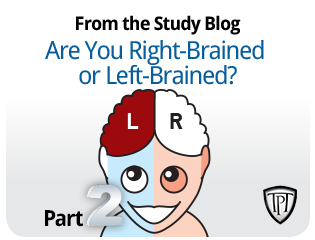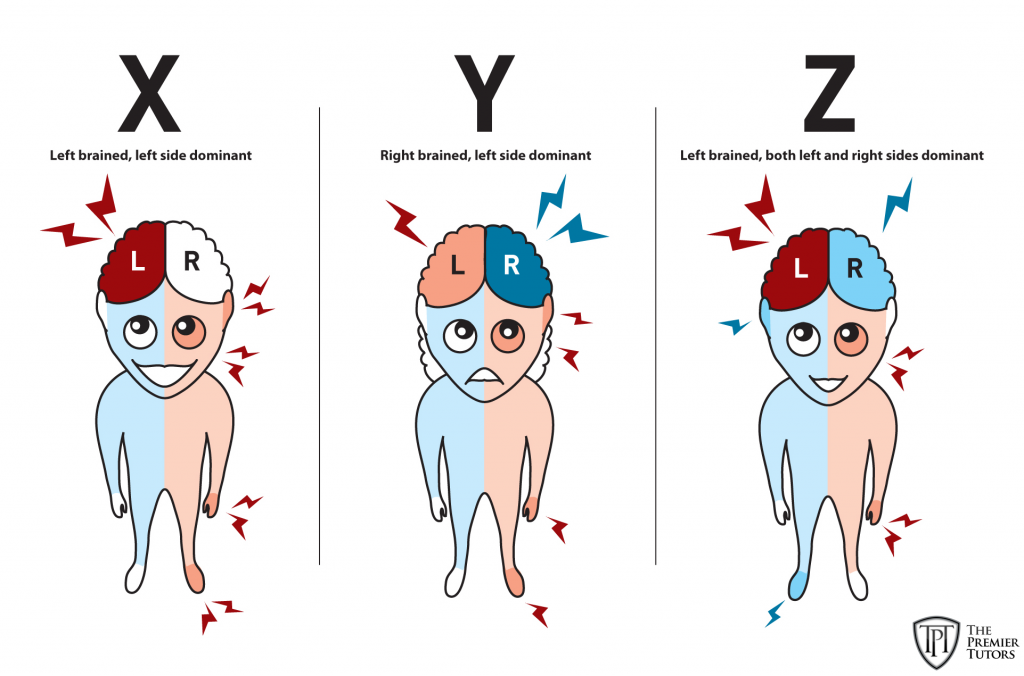
So which side won the arm wrestling contest? Now that you know which side of your brain is dominant, it’s time for you to learn exactly what that means for you as a student (and a real-life human). How can you improve your academic learning/studying techniques?
First, take out the worksheet from our last post. We all use both sides of the brain when we need to, but when we’re stressed, it‘s difficult for the “weaker” hemisphere to take action efficiently. It can sort of freeze up. And one high-stress situation is in school, when you’re learning something new or when you’re taking a dreaded test or quiz.
Take a look at which side you marked as your dominant brain, and which parts of your body are your strongest. Now let’s look at figures “X”, “Y”, and “Z”.
Figure X: He’s left-brained, but all his circled parts are on the right side. Remember, your left-brain controls the right side of your body, and vice versa. So “X” is one lucky student. His brain is always able to send a signal across the corpus callosum (the pathway that connects the left and right sides of your brain), even under stress.
Figure Y: She’s right-brained, but all of her dominant parts are also on the right side. Yikes! This means that when “Y” is stressed, it’s harder for her brain to process information. She can only move/use her dominant parts using her weakest brain hemisphere. It’s hard for her to apply her strongest thoughts/feelings/talents when she’s stressed. When she’s taking a test, and she’s nervous, it’s probably difficult for her to read information, listen to instructions, or write an essay. She’ll benefit from learning relaxation and studying techniques to help her process information.
Figure Z: He’s like most of us. He is left-brained and has dominant parts on either side. While his right-foot and ear are dominant (he’s probably a great athlete and enjoys music), his left-eye and hand are dominant. This means reading is harder for him under pressure. While he may or may not be a good writer at home, he struggles to write essays in class when he’s nervous.
Take a moment to review your chart. Can you identify where your learning strengths and weaknesses are?
What’re Your Best Studying/Learning Techniques?
If you have a body part that is on the opposite side of your brain’s dominant half, that is what want to use as a strength in the classroom. Here are some examples:
Eye
The more you see the information, the better chance you have of recalling it when you are nervous.
Reading/synthesizing visual information is a strength.
Use pictures, graphs, charts, and visually active notes to learn information.
Highlighted passages will help you recall study details.
Ear
Listening, music, and hearing explanations help you remember information.
Invest in a digital recording device to record lectures and listen to them again when you’re studying at home.
Put information to a rhythm or melody to memorize it – “In fourteen-hundred-ninety-two, Columbus sailed the ocean blue!”
Reading out loud can help you remember key information.
Audio books might be more enjoyable for you.
Hand
You’re good with your hands, so writing might be easier for you.
Choose the note taking style you like best.
Make flash cards.
The more you work with information mechanically (writing or typing), the more it will stick.
Foot
You probably like movement and locomotion.
Jiggling your leg under the desk can help anchor your thoughts.
Sit in the back of a room so other students aren’t distracted by your constant motion!
Movement helps you to learn, so you might want to pace when you read at home to keep focused on the information.
Best Learning Styles For Figures X, Y, & Z
Figure X – He can decide which learning methods are best for him because his dominant brain hemisphere controls his dominant parts. He’ll be most interested in the next two blogs which will focus on specific learning styles.
Figure Y – She’s going to need to learn some tricks to help her in school. Deep breathing when she’s nervous can help settle her down. She will want to really pay attention to which learning styles are her favorite. One of her parts: eye/ear/hand (reading/listening/writing) will be her favorite and this is the one she’ll want to cultivate and use the most in the classroom.
Figure Z – He’s going to want to focus on his hearing. He can read aloud at home when he’s studying, record classroom lectures in subjects he struggles with and play them back, and really pay attention to what the teacher says in class. He might want to sit in the back so he can move a little if he needs to when he’s concentrating in class.
Check back next week. You will take a quiz to find out exactly where your learning strengths are so that you can maximize your studying techniques. See you then!




What if you’re right brained but have dominate parts on both sides of the body? 🙁
Then you my friend are the luckiest of the bunch! You get to use both right and left techniques! Try as many as you can and then keep the ones that resonate with you the most! There are also many other resources on the world wide web that talk about lucky learners like yourself, we’ll be joining their ranks soon with another article, so definitely remember to check back! Best of luck! And definitely write back with what you discover! Go Kimberly!
Just came from part one, everything makes sense now! The infographic is killer! Please make more!
Thanks Jesse! We’ve got another one in the works! Check back soon!
Now I am sure that I’m a left brained person but still I will take the test.
well according to the guide, i’m left brained. but i’m nothing like what u have described as a left brained person. I’m never organized. hate maths n science and i never find things black or white. i see most people and situations as gray. does this mean i’m a Y? 🙁
Why wasn’t right-brain, both sides of the body dominant listed on the types?
Great looking graphic but the left/right brain idea is one of the most widely repeated myths about our brains.
“scientists at the University of Utah have debunked the myth with an analysis of more than 1,000 brains. They found no evidence that people preferentially use their left or right brain. All of the study participants — and no doubt the scientists — were using their entire brain equally,”
http://www.livescience.com/39373-left-brain-right-brain-myth.html
http://www.theguardian.com/commentisfree/2013/nov/16/left-right-brain-distinction-myth
love this